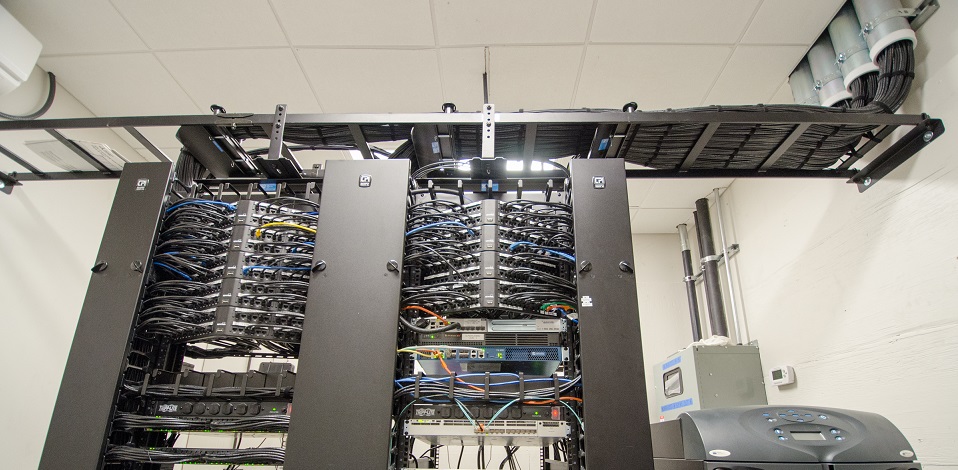Cabling connects each and every technology system that is vital to your business—your phones, computers, audio-visual systems, security cameras, access-control, printers, digital signage, and more. Even “wireless networks” (a true misnomer) must be connected to cabling in order to function.
The structured cabling infrastructure is the foundation of your technology operations, and if it's weak, everything that's connected to it will suffer. In fact, 80% of corporate network problems—including data errors, slow data transmission, lost files—result from faulty cabling.
Telecommunications room at Plaskolite, designed and integrated by IBS
Even though technology is a fundamental business resource (we at IBS call it the “fourth utility”), it’s often overlooked or at best haphazardly planned, particularly the infrastructure cabling. And that neglect can lead to additional and unnecessary expenses.
The best way to avoid the panic and costs associated with an unorganized system is to have a good plan in place upfront.
“80% of corporate network problems result from faulty cabling”
Cabling best practices
Integrated Building Systems recommends the following best practices to keep in mind during the planning phase to keep your cabling system functioning at peak performance.
Use the proper cable for the environment. Not only does this contribute to a safe and organized space, but it keeps your business in line with electric code. Plenum cable will be appropriate 90 percent of the time, even in partially non-plenum environments. This is more fire resistant and lighter, especially important for installation above ceilings.
Keep cables tied into small bundles using cable brackets and Velcro. Large bundles cause a buildup of electromagnetic interference between cable pairs, which poses a heat risk. Small bundles and brackets relieve weight from ceiling cabling, which is safer for offices. Furthermore, Velcro bundling allows you to keep cables evenly spaced while allowing the colored coating of the cables to be seen, which helps with organization.
Use both vertical and horizontal cable management to organize your wiring and keep it functioning properly. Horizontal management is key between patch panels. Vertical management is essential between the racks from top to bottom, ideally with 6 to 10 inches in between.
Color-code your cables. If there is one color for phone cables, another set of patch cords for computers, and a different one for WAPs, then any issues are much easier to troubleshoot.
Invest in the best supplies your budget allows. Cheap cabling may save money upfront, but ultimately it will cost more to constantly replace it than it would to buy better cabling upfront. Stick with name-brand cabling. If you have a larger budget, consider investing in switches for all cables/outlets. With those, cables are patched in at the beginning, so not much needs to be moved when you decide to move phones or computers.
Commit to organization. This means planning well, investing in the proper supplies, and keeping surplus cables on hand. When a good plan is in place from the beginning, cabling will look organized, perform well, and be safe.
Schedule a free cabling consultation
Do you need help with your structured cabling system?
Every project, from basic updates to complex networks, can benefit from the insights gained from design-stage planning and research. Contact Integrated Building Systems to schedule a free consultation. Our team will meet with staff at your facility to discuss your business needs, review existing telecommunication systems and future plans, and make recommendations for achieving your goals.


